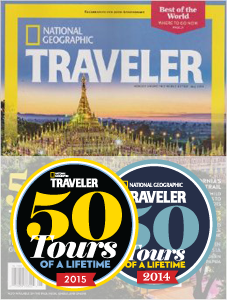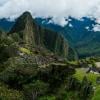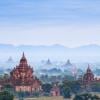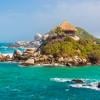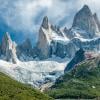Perched high in the Peruvian Andes, Machu Picchu is one of the world’s most iconic archaeological sites. But before you set out to explore its ancient stone terraces and breathtaking views, you’ll need to prepare for the altitude at Machu Picchu. High elevation presents challenges for those who are used to life closer to sea level.
At Global Basecamps, we provide authentic travel experiences that prioritize safety and sustainability. You’ll feel like you’re on top of the world when you visit Machu Picchu–but your well-being should also be a top priority.
Knowing what to expect can help you prepare for the altitude, avoid discomfort, and prevent more serious health concerns. With these tips, you can reach new heights of exhilaration during your once-in-a-lifetime Andean adventure.
Request Your Machu Picchu Visit Quote Today

What Is the Altitude at Machu Picchu?
Machu Picchu, in modern-day Peru, sits at an elevation of approximately 2,430 meters (7,970 feet) above sea level. Nestled between lush mountain peaks and surrounded by the winding Urubamba River, the site’s altitude is lower than many expect—especially compared to other destinations in the Andes Mountains.
How Machu Picchu’s Elevation Compares
- Machu Picchu: 2,430 m (7,970 ft)
- Cusco: 3,400 m (11,150 ft)
- Sacred Valley (Ollantaytambo): 2,792 m (9,160 ft)
- Aguas Calientes (Machu Picchu Pueblo): 2,040 m (6,690 ft)
This means Machu Picchu is lower in elevation than both Cusco and many towns in the Sacred Valley. This can be a relief for travelers concerned about altitude sickness. Before we dive in (or dive up?) to altitude in Peru, we’ll learn about the civilization behind Machu Picchu’s rise.

Explore the Rich History, Cultures, and Languages of Machu Picchu
Machu Picchu is a testament to the ingenuity and cultural richness of the Inca civilization, which flourished in the Andes between the 13th and 16th centuries. Archaeologists believe Machu Picchu was constructed as a royal estate for the Inca emperor Pachacuti (Pachacútec Inca Yupanqui), who reigned from 1438 to 1471.
Built around 1450, the site was occupied for less than a century before being abandoned. Spanish colonialism and the spread of disease had a devastating impact on the Inca and other groups indigenous to North and South America.
The Inca Civilization
The Incas were incredibly skilled master builders and engineers. Machu Picchu’s soaring temples, terraces, bridges, and agricultural fields showcase their architectural brilliance in the challenging Andean environment. With the area’s rugged topography and elevation shifts, the Inca didn’t need to invent the wheel–llamas and alpacas were more efficient than wheeled carts on narrow, winding mountain paths.
Archaeological studies of skeletal remains reveal that many residents were immigrants. Varied diets and health markers are identifiable in their remains. This reflects the vast reach and intercultural relationships within the Inca Empire.
The Quechua Language: A Living Link Between Past and Present
Language played a vital role in unifying this vast, diverse empire. The primary language was Quechua, also known as Runa Simi. Quechua has ancient roots in the Andes, dating back over 5,000 years. It remains an official language in Peru and Bolivia, preserving a living link to the region’s past.
When you visit Machu Picchu with Global Basecamps, you’ll hear one of the oldest languages on Earth still alive today. If you’re a language-lover, give Quechua language learning a try before your trip.
Download Our Free Guide on How to Hike the Inca Trail

Cusco: Your Gateway to the Andes
Most visitors to Machu Picchu begin their journey in Cusco. Cusco is the former capital of the Inca Empire, a vibrant modern city–and the inspiration behind the (hilarious) 2000 Disney movie "The Emperor’s New Groove".
The elevation in Cusco is much higher than Machu Picchu. It’s 3,400 meters (11,150 feet) above sea level. This significant difference in altitude is important to keep in mind. In Cusco, you’ll feel the first effects of the thin mountain air. Keep reading to learn more about altitude in Cusco and Machu Picchu.

An Overview of Altitude Sickness
Altitude sickness is the primary concern for travelers in the Andes Mountains. Here’s what to expect when you begin your journey.
What Is Altitude Sickness?
Altitude sickness is known locally as soroche. This condition occurs when your body struggles to adapt to lower oxygen levels at higher elevations. Sustained low oxygen levels (hypoxia) can lead to internal organ damage if not addressed. Initial symptoms include headaches, nausea, shortness of breath, fatigue, and dizziness.
Who Is Affected?
Anyone can experience altitude sickness, regardless of age or fitness level. It’s most common when ascending rapidly to elevations above 2,500 meters, or 8,200 feet. This makes Cusco a prime location for symptoms to appear. If you have prior health conditions that impact your breathing, be sure to talk to your doctor before traveling to Peru.

Tips for Adjusting to altitude at Machu Picchu and Cusco
- Take It Slow: Spend your first couple of days in Cusco or the Sacred Valley acclimatizing before tackling strenuous activities.
- Stay Hydrated: Drink plenty of water, and avoid excessive alcohol or caffeine, which can contribute to dehydration.
- Eat Light: Opt for smaller, lighter meals to help your body adjust to the change. Healthy snacks can keep up your energy without weighing you down.
- Pack for Success: When traveling to Machu Picchu or hiking the Inca Trail, bringing the right supplies can make all the difference.
- Bring Medication: Consult your doctor about medications like acetazolamide (Diamox) if you have concerns about altitude sickness.
- Rest and Recover: Listen to your body and avoid overexertion, especially on your first day at high altitude.
Fun fact: A local remedy for altitude sickness is mate de coca, an ancient Incan herbal tea. A 1986 study found cocaine metabolites in drug screening results after just one cup–so it might not be the relaxing tea you think!

The Journey From Cusco to Machu Picchu
Many travelers choose to descend into the Sacred Valley a night or two before heading to Machu Picchu. The Sacred Valley is at a lower altitude, so this gradual descent can help you acclimate more comfortably.
How to Get There
There’s more than one way to travel from Cusco to Machu Picchu. Here are the options.
- By Train: The most popular way to reach Machu Picchu is by train from Cusco. You can also go from Ollantaytambo to Aguas Calientes, followed by a short bus ride up to the ruins of Machu Picchu.
- By Trek: Adventurous travelers can hike the Inca Trail or alternative routes like the Salkantay Trail or Lares Route. These treks have significant elevation changes and require good acclimatization.
The Salkantay Route is a 7-day hike. The Lares Route has 5- and 7-day hike options. If you’re the outdoorsy type, you can bring backpacking equipment for an authentic mountain backpacking experience. Or, you can plan lodge-to-lodge hiking in Peru. This means you always have somewhere comfortable to rest and recharge after your hike!

How Does the Altitude at Machu Picchu Affect Your Experience?
While the altitude at Machu Picchu is less than the surrounding areas, your trip will take you from highs to lows and everywhere in between. The elevation shifts can be challenging, so it’s important to acclimate and prepare your muscles for all the movement.
Physical Activity
Exploring Machu Picchu involves walking, climbing stairs, and sometimes hiking steep paths. Depending on what you’re used to, the altitude may still affect you. You’ll get winded more easily than at sea level. Take your time, rest when needed, and enjoy the views.
Weather and Climate
At 2,430 meters, Machu Picchu enjoys a subtropical highland climate. Days are often mild and sunny, while nights can be cool. The weather can change rapidly, though. Dress in layers, with moisture-wicking material, and be prepared for both rain and shine.
Final Tips
- Plan for acclimatization time in your itinerary.
- Pack light layers for changing weather conditions.
- Bring sun protection–UV rays are stronger at high elevations.
- Enjoy the journey! The dramatic landscapes, local wildlife, unique culture, and fascinating history of the Andes are as memorable as Machu Picchu itself.

FAQs About the Altitude at Machu Picchu
Q: Will I get altitude sickness at Machu Picchu?
A: Most travelers experience more symptoms in Cusco than at Machu Picchu due to the higher elevation in the city. However, it’s still wise to take precautions and acclimatize before your visit.
Q: Is the altitude at Machu Picchu higher than Cusco?
A: No, Machu Picchu is about 1,000 meters (over 3,000 feet) lower than Cusco.
Q: What’s the best way to acclimatize before visiting Machu Picchu?
A: Spend a day or two in Cusco or the Sacred Valley, stay hydrated, and avoid strenuous activity at first.
Q: Can children or older adults handle the altitude?
A: Most healthy travelers of all ages can visit Machu Picchu, but those with heart or respiratory conditions should consult a doctor before traveling.

Ready to Experience Machu Picchu?
Now that you’re prepared for the altitude at Machu Picchu and Cusco, it’s time to plan your journey. Explore ancient ruins, experience the culture of the Andes Mountains, and create memories that will last a lifetime with Global Basecamps. Reach out today for your Machu Picchu travel quote.

